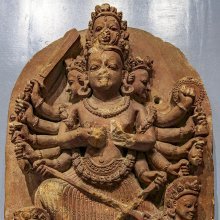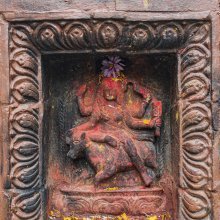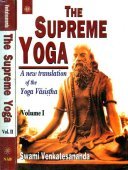Kalaratri, Kala-ratri, Kālarātri, Kālarātrī, Kalarātri: 25 definitions
Introduction:
Kalaratri means something in Hinduism, Sanskrit, Jainism, Prakrit, Marathi. If you want to know the exact meaning, history, etymology or English translation of this term then check out the descriptions on this page. Add your comment or reference to a book if you want to contribute to this summary article.
Images (photo gallery)
In Hinduism
Shaktism (Shakta philosophy)
Source: Wisdom Library: ŚāktismKālarātri (कालरात्रि, “Dark Night”):—One of the names of Mahākālī (tamas-form of Mahādevī). Mahākālī is one of the three primary forms of Devī. Not to be confused with Kālī, she is a more powerful cosmic aspect (vyaṣṭi) of Devi and represents the guṇa (universal energy) named tamas. For reference, see the Devī Māhātmya, a Sanskrit work from the 5th century, incorporated into the Mārkaṇḍeya-Purāṇa.
Source: Google Books: Manthanabhairavatantram1) Kālarātrī (कालरात्री) refers to one of the eight Yoginīs associated with Jālandhara (which is in the southern quarter), according to the Manthānabhairavatantra, a vast sprawling work that belongs to a corpus of Tantric texts concerned with the worship of the goddess Kubjikā.—[...] The eight Yoginīs: Divyayoginī, Mahāyoginī, Siddhayoginī, Gaṇeśvarī, Śākinī, Kālarātrī, Ūrdhvakeśī, Revatī
2) Kālarātrī (कालरात्री) refers to one of the thirty-two Bhairavīs (also Dūtis) embodying the syllables of the goddess’s Vidyā, according to the Manthānabhairavatantra.—The thirty-two Bhairavīs [i.e., Kālarātrī] are the consorts of the Bhairavas presiding over the sonic energies of the thirty-two syllables of her Vidyā.
Source: Red Zambala: The 10 Great Wisdom GoddessesThe night of Dhūmāvatī is Kālarātri (कालरात्रि, “the Night-of-Death”) — during the 4 months of the monsoon no public ritual can be performed, there are no pilgrimages, no festivals, no marriages, no initiation. At the end of the rainy period the rule of light returns and the festival of lights (Dīpāvalī) takes place.
Source: Hare-Krsna: Nava-DurgāKālarātrī (कालरात्री) refers to one of the nine Navadurgā which literally means the “nine forms of Goddess Durgā”, and constitute, according to Vedic scriptures, the manifestation of Durgā in Her nine different aspects. [...] Each goddess [viz., Kālarātrī] has a different form and a special significance.
Source: Brill: Śaivism and the Tantric Traditions (shaktism)Kālarātri (कालरात्रि) or Nidrā refers to the Kṛṣṇa’s sister which was worshiped as part of the Navarātra Tantric rituals.—Various 4th century sources refer to the worship of Kṛṣṇa’s sister Kālarātri/Nidrā, a dark, blood-thirsty, alcohol-loving goddess associated with night, sleep, hallucination and enchantment (māyā).—Sources for the rituals such as the worship of Kālarātri include: Harivaṃśa 57.35–36; Mahābhārata 4.5.29ff. and 6.22.6ff., old Skandapurāṇa 60.46; Kādambarī pp. 30–31; Harṣacarita p. 126; Caṇḍīśataka 16; Gaüḍavaho 318, 319, Purāṇic citations in Dharmaśāstric compendia from Mithilā and Bengal.)

Shakta (शाक्त, śākta) or Shaktism (śāktism) represents a tradition of Hinduism where the Goddess (Devi) is revered and worshipped. Shakta literature includes a range of scriptures, including various Agamas and Tantras, although its roots may be traced back to the Vedas.
Purana and Itihasa (epic history)
Source: Wisdom Library: Varāha-purāṇaKālarātri (कालरात्रि, “the night of time”) is a name of the Goddess Raudrī referring to her terrific form engaged in destruction, according to the Varāhapurāṇa chapter 96. Raudrī is the form of Trikalā having a black body representing the energy of Maheśvara (Śiva). Trikalā is the name of a Goddess born from the combined looks of Brahmā, Viṣṇu and Maheśvara (Śiva).
The Varāhapurāṇa is categorised as a Mahāpurāṇa, and was originally composed of 24,000 metrical verses, possibly originating from before the 10th century. It is composed of two parts and Sūta is the main narrator.
Source: archive.org: Puranic EncyclopediaKālarātri (कालरात्रि).—The Devatā presiding over the night on the eve of death. The fierce aspect of the Devatā is described in the Mahābhārata as follows:—
Coal-black in colour, with swollen mouth and eyes and wearing red garlands and clothings—thus appeared the woman (Devatā) presiding over the death-night. With the fierce cord in her hand she drags away the souls of the dead. (Sauptika Parva, Chapter 9).
Source: Cologne Digital Sanskrit Dictionaries: The Purana IndexKālarātrī (कालरात्री).—A varṇa śakti.*
- * Brahmāṇḍa-purāṇa IV. 44. 60.

The Purana (पुराण, purāṇas) refers to Sanskrit literature preserving ancient India’s vast cultural history, including historical legends, religious ceremonies, various arts and sciences. The eighteen mahapuranas total over 400,000 shlokas (metrical couplets) and date to at least several centuries BCE.
Kavya (poetry)
Source: Wisdom Library: Kathāsaritsāgara1) Kālarātri (कालरात्रि) is the name of a Brāhman woman who was expert in the magic power of witches, such as flying through the air, according to the Kathāsaritsāgara, chapter 20.
2) Kālarātri (कालरात्रि) is the name of the southern opening of mount Kailāsa or the deity thereof, as mentioned in the Kathāsaritsāgara, chapter 109. Accordingly, “... when Śiva had been thus supplicated by the mountain [Kailāsa], he placed in the cave, as guards, elephants of the quarters, mighty basilisks, and Guhyakas; and at its southern opening Kālarātri, the invincible Caṇḍikā”.
Also, as Dhanavatī and Devamāya said to Naravāhanadatta: “your Majesty, Kālarātri is always near this opening. She was originally created by Viṣṇu, when the sea was churned for the nectar, in order that she might tear in pieces the chiefs of the Dānavas, who wished to steal that heavenly drink. And now she has been placed here by Śiva to guard this cave, in order that none may pass it except those beings, like yourself, of whom we spoke before. You are our emperor and you have obtained the jewels, and have passed this cave; so, in order to gain the victory, you must worship this goddess, who is a meet object of worship”.
The Kathāsaritsāgara (‘ocean of streams of story’), mentioning Kālarātri, is a famous Sanskrit epic story revolving around prince Naravāhanadatta and his quest to become the emperor of the vidyādharas (celestial beings). The work is said to have been an adaptation of Guṇāḍhya’s Bṛhatkathā consisting of 100,000 verses, which in turn is part of a larger work containing 700,000 verses.

Kavya (काव्य, kavya) refers to Sanskrit poetry, a popular ancient Indian tradition of literature. There have been many Sanskrit poets over the ages, hailing from ancient India and beyond. This topic includes mahakavya, or ‘epic poetry’ and natya, or ‘dramatic poetry’.
Ayurveda (science of life)
Toxicology (Study and Treatment of poison)
Source: Shodhganga: Kasyapa Samhita—Text on Visha ChikitsaKālarātrī (कालरात्री) refers to one of the four fangs of a snake (Daṃṣṭraka), as taught in the Nāgajanman (“birth of the Snakes”) section of the Kāśyapa Saṃhitā: an ancient Sanskrit text from the Pāñcarātra tradition dealing with both Tantra and Viṣacikitsā—an important topic from Āyurveda which deals with the study of Toxicology (Agadatantra or Sarpavidyā).—After 52 days, four fangs, namely Kālī, Karālī, Kamarī and Kālarātrī make their appearance on the left and right sides which are the receptacle of venom.
Unclassified Ayurveda definitions
Source: Ancient Science of Life: Snake bite treatment in Prayoga samuccayamKalarātri (कलरात्रि) refers to a type of snake-bite that “resembles foot of a bird with sandal wood smell”, according to the 20th century Prayogasamuccaya (one of the most popular and widely practised book in toxicology in Malayalam).—[...] The author has given a detailed description of types of bite mark and the corresponding causes and prognosis... If vital parts in body such as forehead, cheeks, nose, ears, temples, palmar surface of hands, nipples, cardiac area, axillary area, umbilicus, groins and thighs are bitten, the chance of survival becomes doubtful. Four types of poisonous teeth and their prognosis are mentioned, which are: [viz., Kalarātri, ‘bite resembles foot of a bird with sandal wood smell’ ...]
Source: gurumukhi.ru: Ayurveda glossary of termsKālarātri (कालरात्रि):—The night of all destroying time, night of destruction, the end of the world, the night of man’s death. this context is explained while discribing the ill effect of sleep, I, e excessive, untimely and negatively take away the happiness and life like other death night.

Āyurveda (आयुर्वेद, ayurveda) is a branch of Indian science dealing with medicine, herbalism, taxology, anatomy, surgery, alchemy and related topics. Traditional practice of Āyurveda in ancient India dates back to at least the first millenium BC. Literature is commonly written in Sanskrit using various poetic metres.
Shilpashastra (iconography)
Source: Google Books: Manthanabhairavatantram (shilpa)Kālarātri (कालरात्रि) refers to a form of Kālī, installed in a temple in Varanasi (located in Kālikā galli, house number D 8/17).—Kālarātri is worshipped as the seventh of the Nine Durgās during the festival of the Nine Nights (navarātri) dedicated to the goddess Durgā. The idol is quite large. The face of the goddess is clearly visible and a long red tongue extends from her mouth down into an apron that covers her body. Lifting the apron we see that the goddess is squatting, her legs splayed on a Liṅga and her tongue extends down to the junction where it penetrates her.
Note: Kālarātri is one of the Nine Durgās listed and described in the Armour of Durgā (durgākavaca), a supplement (aṅga) of the Devīmāhātmya. There the dark Kālarātri with dishevelled hair wears a brilliant, shining rosary and rides a donkey. Clearly, the idol in the temple is quite different. This Kālarātri is also worshipped as Kālī, the first of the Ten Mahāvidyās. Although, like her identification with one of the Nine Durgās, this is an adventitious projection, her iconography is clearly more compatible with this association

Shilpashastra (शिल्पशास्त्र, śilpaśāstra) represents the ancient Indian science (shastra) of creative arts (shilpa) such as sculpture, iconography and painting. Closely related to Vastushastra (architecture), they often share the same literature.
In Jainism
General definition (in Jainism)
Source: archive.org: The Jaina IconographyKālarātrī (कालरात्री) is the name of a Yoginī mentioned in various Jaina manuscripts, often being part of a list of sixty-four such deities. How the cult of the Tantrik Yoginīs originated among the vegetarian Jainas is unknown. The Yoginīs (viz., Kālarātrī) are known as attendants on Śiva or Pārvatī. But in the case of Jainism, we may suppose, as seen before that they are subordinates to Kṣetrapāla, the chief of the Bhairavas.

Jainism is an Indian religion of Dharma whose doctrine revolves around harmlessness (ahimsa) towards every living being. The two major branches (Digambara and Svetambara) of Jainism stimulate self-control (or, shramana, ‘self-reliance’) and spiritual development through a path of peace for the soul to progess to the ultimate goal.
Languages of India and abroad
Marathi-English dictionary
Source: DDSA: The Molesworth Marathi and English Dictionarykālarātri (कालरात्रि).—m S The night occurring on the 7th day of the 7th month of every 77th year. The popular understanding of this word, and of its derivative kālarātra f is, according to some, the 8th of the bright half of āśvina, according to others, the 8th of the dark half of śrāvaṇa, the birthnight of kālī. 2 The last night of a kalpa. 3 A dark (not moonlit) night gen.
Marathi is an Indo-European language having over 70 million native speakers people in (predominantly) Maharashtra India. Marathi, like many other Indo-Aryan languages, evolved from early forms of Prakrit, which itself is a subset of Sanskrit, one of the most ancient languages of the world.
Sanskrit dictionary
Source: DDSA: The practical Sanskrit-English dictionaryKālarātri (कालरात्रि) or Kālarātrī (कालरात्री).—f.
1) a dark night.
2) a sister of Yama.
3) the Amāvasyā on which lamps are lighted (in the Divali holidays).
4) the night of destruction at the end of the world (identified with Durgā); कालरात्रीति तां (kālarātrīti tāṃ) (sītāṃ) विद्धि सर्वलङ्का- विनाशिनीम् (viddhi sarvalaṅkā- vināśinīm) Rām.5.51.34.
5) a particular night in the life of man, on the 7th day of the 7th month of the 77th year.
Derivable forms: kālarātriḥ (कालरात्रिः).
Kālarātri is a Sanskrit compound consisting of the terms kāla and rātri (रात्रि).
Source: Cologne Digital Sanskrit Dictionaries: Edgerton Buddhist Hybrid Sanskrit DictionaryKālarātrī (कालरात्री).—name of a rākṣasī: Mahā-Māyūrī 243.25.
Source: Cologne Digital Sanskrit Dictionaries: Shabda-Sagara Sanskrit-English DictionaryKālarātri (कालरात्रि).—m.
(-triḥ) 1. A particular night, one which occurs on the 7th day of the 7th month of every 77th years; after such a period of life, a man is exempt from attention to the usual ordinances. 2. The last night of a Kalpa 3. A dark night. 4. A form of Sakti or Durga. E. kāla black, time, and rātri a night: see bhīmarathī.
Source: Cologne Digital Sanskrit Dictionaries: Benfey Sanskrit-English DictionaryKālarātri (कालरात्रि).—f. 1. the last night of a Kalpa, in which the universe is destroyed by Kāla, [Rāmāyaṇa] 5, 47, 26. 2. Durgā, [Harivaṃśa, (ed. Calc.)] 3269. 3. = bhīmarathī, see ratha. Yakṣa-rātri, f. the night of full moon in the month Kārttika. Śiva-rātri, f. a festival in honour of Śiva. Śeṣa-rātri, f. the last watch of the night.
Kālarātri is a Sanskrit compound consisting of the terms kāla and rātri (रात्रि).
Source: Cologne Digital Sanskrit Dictionaries: Monier-Williams Sanskrit-English Dictionary1) Kālarātri (कालरात्रि):—[=kāla-rātri] [from kāla] 1. kāla-rātri f. a dark night, [Horace H. Wilson]
2) [v.s. ...] (for 2. -rātri See p. 278, col. 3.)
3) Kālarātrī (कालरात्री):—[=kāla-rātrī] [from kāla] a f. a dark night, [Horace H. Wilson]
4) Kālarātri (कालरात्रि):—[=kāla-rātri] [from kāla] 2. kāla-rātri f. the night of all-destroying time, night of destruction at the end of the world (often personified and identified with Durgā or with one of her Śaktis), [Mahābhārata; Rāmāyaṇa] etc.
5) [v.s. ...] the night of a man’s death, [Pañcadaṇḍacchattra-prabandha]
6) [v.s. ...] a particular night in the life of a man (on the seventh day of the seventh month of the seventy-seventh year, after which period a man is exempt from attention to the usual ordinances), [cf. Lexicographers, esp. such as amarasiṃha, halāyudha, hemacandra, etc.]
7) [v.s. ...] Name of a Brāhman woman (skilled in magic), [Kathāsaritsāgara xx, 104.]
8) Kālarātrī (कालरात्री):—[=kāla-rātrī] [from kāla] b f. the night of all-destroying time, night of destruction at the end of the world (often personified and identified with Durgā or with one of her Śaktis), [Mahābhārata; Rāmāyaṇa] etc.
9) [v.s. ...] the night of a man’s death, [Pañcadaṇḍacchattra-prabandha]
10) [v.s. ...] a particular night in the life of a man (on the seventh day of the seventh month of the seventy-seventh year, after which period a man is exempt from attention to the usual ordinances), [cf. Lexicographers, esp. such as amarasiṃha, halāyudha, hemacandra, etc.]
11) [v.s. ...] Name of a Brāhman woman (skilled in magic), [Kathāsaritsāgara xx, 104.]
Source: Cologne Digital Sanskrit Dictionaries: Yates Sanskrit-English DictionaryKālarātri (कालरात्रि):—[kāla-rātri] (triḥ) 2. m. A particular night, as that of the 7th day of the 7th month of the 77th year of life; a dark night; final night of a Kalpa; form of Durgā.
[Sanskrit to German]
Sanskrit, also spelled संस्कृतम् (saṃskṛtam), is an ancient language of India commonly seen as the grandmother of the Indo-European language family (even English!). Closely allied with Prakrit and Pali, Sanskrit is more exhaustive in both grammar and terms and has the most extensive collection of literature in the world, greatly surpassing its sister-languages Greek and Latin.
Kannada-English dictionary
Source: Alar: Kannada-English corpusKālarātri (ಕಾಲರಾತ್ರಿ):—
1) [noun] a night that is absolutely dark.
2) [noun] the night of all-destroying time; the time of dissolution of the universe 3) a formidable form of Goddess Pārvati.
3) [noun] the new-moon day of Āśvayuja month (last day of the seventh month) of Hindu Lunar calendar.
--- OR ---
Kāḷarātri (ಕಾಳರಾತ್ರಿ):—
1) [noun] a night that is absolutely dark.
2) [noun] the night of all-destroying time; the time of dissolution of the universe.
3) [noun] a formidable form of Goddess Pārvati.
4) [noun] the new-moon day of Āśvayuja month (last day of the seventh month) of Hindu Lunar calendar.
Kannada is a Dravidian language (as opposed to the Indo-European language family) mainly spoken in the southwestern region of India.
Nepali dictionary
Source: unoes: Nepali-English DictionaryKālarātrī (कालरात्री):—n. 1. dark and dangerous night; 2. night of the dissolution of the world; 3. one of the nine nights in Dashain festival in which Goddess Durga is worshipped and sacrifices are made; 4. Mythol. Goddess Durga's form;
Nepali is the primary language of the Nepalese people counting almost 20 million native speakers. The country of Nepal is situated in the Himalaya mountain range to the north of India.
See also (Relevant definitions)
Starts with: Kalaratricandikavidhana, Kalaratrikalpe, Kalaratrimahakalpa.
Ends with: Vikalaratri.
Full-text (+253): Bhimarathi, Dharmaratri, Moharatri, Shikhandini, Raktanulepana, Raktamalya, Raktanayana, Kali, Raktambara, Nidra, Raktasya, Pashahasta, Urdhvakeshi, Mahayogini, Ganeshvari, Divyayogini, Rudhirashani, Digvasa, Kalavaktra, Asani.
Relevant text
Search found 17 books and stories containing Kalaratri, Kaalaratri, Kāla-rātri, Kala-ratri, Kāla-rātrī, Kālarātri, Kālarātrī, Kalarātri, Kāḷarātri; (plurals include: Kalaratris, Kaalaratris, rātris, ratris, rātrīs, Kālarātris, Kālarātrīs, Kalarātris, Kāḷarātris). You can also click to the full overview containing English textual excerpts. Below are direct links for the most relevant articles:
Yoga Vasistha [English], Volume 1-4 (by Vihari-Lala Mitra)
Chapter LXXXI - Description of the last night of death or general doom < [Book VII - Nirvana prakarana part 2 (nirvana prakarana)]
Chapter lxxviii < [Book III - Utpatti khanda (utpatti khanda)]
Kathasaritsagara (the Ocean of Story) (by Somadeva)
Chapter XX < [Book III - Lāvānaka]
The motif of overhearing conversations < [Notes]
Chapter CIX < [Book XV - Mahābhiṣeka]
The Devi Bhagavata Purana (by Swami Vijñanananda)
Chapter 11 - On the killing of Madhu Kaiṭabha < [Book 10]
Chapter 10 - On the anecdote of the King Suratha < [Book 10]
Chapter 24 - On the worship of the Devī < [Book 8]
The Skanda Purana (by G. V. Tagare)
Chapter 71 - Exploits of Durgā < [Section 2 - Uttarārdha]
Chapter 15 - Turbulence of the Annihilation (Pralaya) < [Section 3 - Revā-khaṇḍa]
Chapter 14 - Kālarātri Annihilates the Universe < [Section 3 - Revā-khaṇḍa]
Harivamsha Purana (by Manmatha Nath Dutt)
Chapter 108 - Shamvara’s Death < [Book 2 - Vishnu Parva]
Related products



